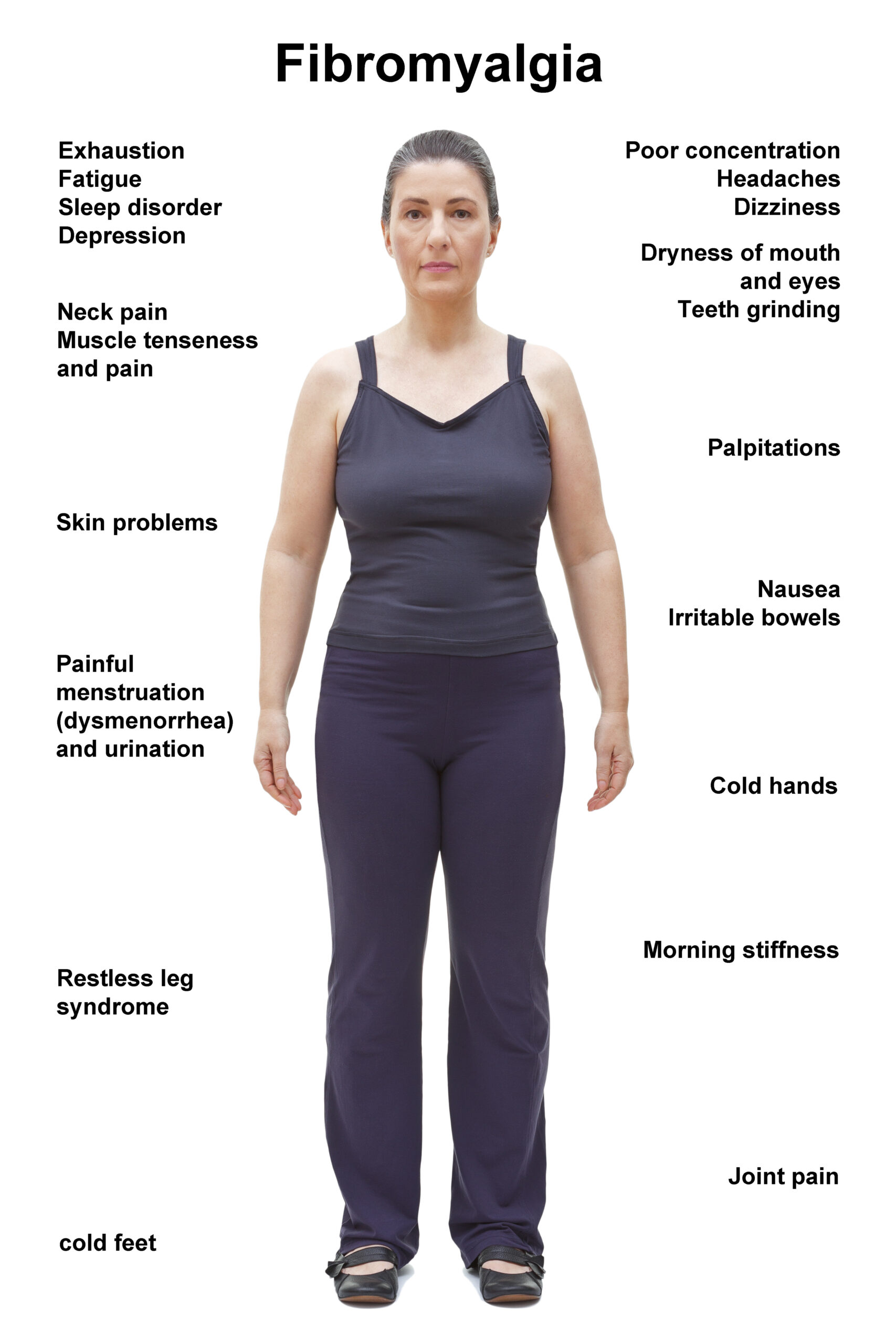Managing the Symptoms – EULAR and NICE Recommendations
Recommendations For Fibromyalgia Patients Prior to 2015
Patients are told that they should try to manage the symptoms of fibromyalgia as best they can because there is no definitive cure. Until recently, the first treatment or therapy offered by doctors was usually prescribed medications; but, only three medications are approved by the Food and Drugs Administration (FDA) in the US for the management of fibromyalgia: duloxetine, milnacipran and pregabalin. However, fibromyalgia patients taking approved medications often do not experience a significant reduction of their symptoms; many also experience intolerable side-effects. As a result, the American College of Rheumatology (ACR) recommend eight different medications for use by fibromyalgia patients in the US: pregabalin, gabapentin, duloxetine, milnacipran, cyclobenzaprine, tramadol, amitriptyline and venlafaxine. 16.
EULAR’s Recommendations for Managing the Symptoms of Fibromyalgia
Meanwhile, for UK patients, EULAR (European League Against Rheumatism), the ACR’s European counterparts, first published recommendations for the management of fibromyalgia in 2005. However, there was little scientific evidence of therapies that were effective at that time, so the recommendations were mostly based on expert opinion. 17. In order to see the difference between types of therapy, therapies are split into Pharmacological (Medication) Therapy and Non-Pharmacological (Non-Medication) Therapy.
In 2005, only heated pool treatment with or without exercise (non-pharmacological therapy) and a number of medications (pharmacological therapy) were recommended to manage the condition. This was due to experts at that time believing that only these therapies had strong evidence of being effective. Therefore, recommended medications were advised as follows: Tramadol to manage pain in fibromyalgia; Antidepressants (amitriptyline, fluoxetine, duloxetine, milnacipran, moclobemide and pirlindole) to reduce pain and improve function in fibromyalgia patients; and tropisetron, pramipexole and pregabalin to reduce pain in fibromyalgia patients. As a result of these recommendations, medications were usually the first treatments suggested by doctors from 2005.
Current Recommendations for Managing Fibromyalgia Symptoms
Fast forward to 2015 when the EULAR recommendations were reviewed and updated based on a greater number of relevant scientific studies, as opposed to ‘expert opinion’. As a result, the recommendations have changed significantly. So, now the only therapy with strong evidence of being effective in the treatment of fibromyalgia is exercise. 17. Consequently, EULAR now recommend that non-pharmacological therapy should be first-line therapy, alongside patient education.
Individualised Therapy Should be Offered According to Patient Need
The recommendations state, that if non-pharmacological therapy is not effective, then individualised therapy should be offered according to patient need. This may involve: psychological therapies (for mood disorders and unhelpful coping strategies); pharmacotherapy (for severe pain or sleep disturbance); and/or a multimodal rehabilitation programme (for severe disability). However, all these other therapies, including medication, have weak evidence of being effective in the management of fibromyalgia (see Tables 1 and 2). As a result of scientific research, medications now recommended for fibromyalgia are low dose amitriptyline, duloxetine or milnacipran, tramadol, pregabalin and cyclobenzaprine. However, they should only be prescribed if non-pharmacological therapy has been tried and is ineffective.
EULAR 2015 Recommended Non-Pharmacological (Non-Medication) Therapies
| Non-Pharmacological Therapy | Description | Benefits | Level of evidence |
| Aerobic and strengthening exercise | Exercise that works and strengthens muscles of the body, either on land or in water. | Can reduce pain. Although it may increase pain at the very beginning, resistance training with weights, may be beneficial also. | Supported by a lot of evidence |
| Cognitive behavioural therapy (CBT) | A talking therapy that teaches you to challenge negative ideas. It may help you to change the way you think and behave. | This could help to manage the pain of fibromyalgia and give you ways of coping. | Quite a lot of evidence |
| Multi-component therapies | May include different combinations of exercise, education, relaxation, or some other specific treatments such as Tai Chi or massage. | This can help to deliver short-term improvements in pain and fatigue. | Some evidence |
| Acupuncture | Traditional or electric acupuncture | Can help to improve pain when added to other treatments. | Some evidence |
| Hydrotherapy | Hydrotherapy (warm water therapy) or spa therapy sessions | Can deliver improvements that last for up to 14 weeks. | Some evidence |
| Meditative movement therapies and mindfulness-based stress reduction | Meditative movement techniques such as Qigong, Yoga or Tai Chi or the practice of mindfulness and stress-reduction. | Can help to improve sleep and fatigue. | Some evidence |
Table 1: 2015 EULAR Recommended non-pharmacological therapies for managing the symptoms of fibromyalgia 17.
EULAR 2015 Recommended Pharmacological (Medication) Therapies
| Pharmacological Therapy (Medication) | Description | Benefits | Level of evidence |
| Lose-dose amitriptyline | Amitriptyline is a tricyclic antidepressant drug. | Can help to reduce pain and fatigue as well as improving sleep quality when taken at low doses of up to 25 mg per day. | Some evidence |
| Duloxetine or milnacipran | SNRI antidepressant drug | Should be considered in people with severe pain. | Some evidence |
| Tramadol | A weak type of opioid drug. | Should be considered in people with severe pain. | Some evidence |
| Pregabalin | An anti-convulsant drug | May be useful in fibromyalgia to reduce pain and improve sleep. It should be considered in people with severe pain or sleep disturbance caused by fibromyalgia. | Some evidence |
| Cyclobenzaprine | Muscle relaxant | Can help to improve sleep, but most people also experience side effects. It should be considered in people with sleep disturbance caused by fibromyalgia. | Some evidence |
Table 2: 2015 EULAR Recommended pharmacological therapies for managing the symptoms of fibromyalgia 17.
NICE Guidelines
UK GPs also follow the National Institute for Health and Care Excellence (NICE). Fibromyalgia falls under the chronic pain guidelines: “Chronic pain (primary and secondary) in over 16s: assessment of all chronic pain and management of chronic primary pain“. The latest version is from April 2021. Similar to EULAR, NICE recognise that most pain medications (opioids and gapapentinoids) are not effective for long-term use. However, they do recommend the off-label use of amitriptyline, citalopram, duloxetine, fluoxetine, paroxetine or sertraline, for people aged 18 years and over to manage chronic primary pain, after a full discussion of the benefits and harms. NICE recognise that these medicines may help with quality of life, pain, sleep and psychological distress, even in the absence of a diagnosis of depression.
NICE state that the following medications should not be prescribed for chronic pain:
- antiepileptic drugs including gabapentinoids, unless gabapentinoids are part of a clinical trial for complex regional pain syndrome (see the recommendation for research on pharmacological interventions)
- antipsychotic drugs
- benzodiazepines
- corticosteroid trigger point injections
- ketamine
- local anaesthetics (topical or intravenous), unless as part of a clinical trial for complex regional pain syndrome (see the recommendation for research on pharmacological interventions)
- local anaesthetic/corticosteroid combination trigger point injections
- non-steroidal anti-inflammatory drugs
- opioids
- paracetamol.
Recommendations for Patients Currently Prescribed These Medications
They also recommend that GPs review the prescriptions of patients currently prescribed any of these medications. If the patient benefits from the medication, a shared plan should be agreed to maintain a low and safe dose. Alternatively, GPs should explain the risks of continuing if patients report little benefit or significant harm, and encourage and support them to reduce and stop the medicine if possible.
NICE also recommend non-pharmacological therapies for chronic pain. They recommend exercise, psychological therapy (acceptance and commitment therapy (ACT) or cognitive behavioural therapy (CBT), acupuncture, and electrical physical modalities (TENS, ultrasound and interferential therapy).
Conclusion
Overall, the recommendations advise using a mix of approaches to manage your fibromyalgia. But, these will depend on your specific symptoms and circumstances. Although these recommendations were based on a greater number of scientific studies than the 2005 recommendations, the authors acknowledge that the evidence up to 2015 is still modest. Further relevant scientific research has continued over the past 6 years. So, I will examine the evidence on the different types of alternative therapies that have some effect on fibromyalgia and give you an insight into each.
Next: Medication for Fibromyalgia – Why it May Not be the Answer
References
16. Liu, Y., Qian, C. and Yang, M., 2016. Treatment patterns associated with ACR-recommended medications in the management of fibromyalgia in the United States. Journal of managed care & specialty pharmacy, 22(3), pp.263-271.
17. Carville, S.F., Arendt-Nielsen, S., Bliddal, H., Blotman, F., Branco, J.C., Buskila, D., Da Silva, J.A.P., Danneskiold-Samsøe, B., Dincer, F., Henriksson, C. and Henriksson, K.G., 2008. EULAR evidence-based recommendations for the management of fibromyalgia syndrome. Annals of the rheumatic diseases, 67(4), pp.536-541.





